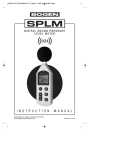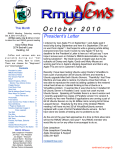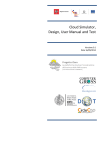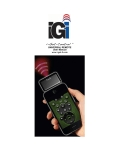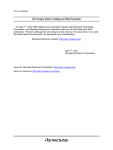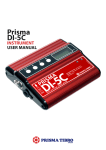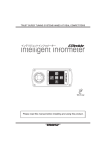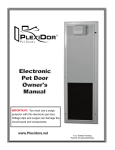Download RE21 Airbag Systems - I-CAR Repairability Technical Support Portal
Transcript
Uniform Procedures For Collision Repair RE21 Airbag Systems © Copyright 1999 Inter-Industry Conference On Auto Collision Repair v.4.0 1. Description This procedure describes methods for the repair, replacement, inspection, and testing of airbag systems. 2. Purpose The purpose of this procedure is to provide industry-accepted requirements for performing high-quality repair of airbag systems. This procedure is intended for use by professionals who are qualified through training and experience. 3. Referenced Documents The following documents are considered part of this procedure by reference. 3.1 Procedures HM01 ME01 PS01 RE01 RE31 RE41 Hazardous Materials Three-Dimensional Measuring Personnel Safety Seat Belt Tensioners, Seat Belt Knee Bolster 3.2 Other Information Equipment-specific information Vehicle-specific diagnostic information Vehicle-specific repair information I-CAR information 4. Equipment And Material Requirements 4.1 Equipment The use of this equipment is included in this procedure: ❏ digital volt-ohm meter (DVOM) ❏ jumper wires ❏ electro-static discharge (ESD) strap Caution: Ensure that the DVOM has an output less than 10 mA (0.01 A) on the lowest ohmmeter range, with the probes shorted. Various airbag systems may require these additional items: ❏ ❏ ❏ ❏ ❏ ❏ ❏ airbag simulator or load tool shorting bar or connector universal or vehicle-specific breakout box universal or vehicle-specific scan tool vehicle-specific airbag system tester vehicle-specific test harness special wire repair tools (contʼd) © Copyright 1999 Inter-Industry Conference On Auto Collision Repair v.4.0 RE21–2 4. Equipment And Material Requirements (cont'd) Follow the vehicle makerʼs recommendations. This equipment may be required for manually deploying airbag modules: ❏ ❏ ❏ ❏ vehicle-specific manual deployment tool switch or special deployment tool 6 m (20 ft) wiring harness charged battery 10 5. Damage Analysis 5.1 Airbag Parts Inspect these airbag system parts for damage: ❏ ❏ ❏ ❏ ❏ ❏ ❏ ❏ ❏ airbag module and trim cover airbag system labels clock spring diagnostic, backup power, and resistor modules and brackets sensors and sensor brackets wiring harnesses and connectors knee bolster or diverter (see RE41) seat belts (see RE01) seat belt tensioners, if equipped (see RE31) If an airbag deployment occurred, refer to the vehicle makerʼs information for parts that must be inspected, tested, and replaced. Vehicle makers may require replacement of all seat belts in use during a collision of specified severity, or if there was an airbag deployment. Follow the vehicle makerʼs recommendations. Damaged airbag system parts must be replaced with new parts. Vehicle makers may allow minor repairs of the wiring harness. Follow the vehicle makerʼs recommendations. 5.2 Related And Adjacent Parts Inspect the following related and adjacent parts for damage: ❏ ❏ ❏ ❏ dash panel and support brackets inner door trim panels instrument panel steering column braces seats and headrests © Copyright 1999 Inter-Industry Conference On Auto Collision Repair (contʼd) v.4.0 RE21–3 10 ❏ ❏ ❏ ❏ ❏ ❏ ❏ 5. Damage Analysis (cont'd) steering column steering column levers and switches steering wheel steering wheel-mounted accessories, such as horn, etc. windshield for damage and proper adhesion to the opening integrated child seat, if equipped (see RE51) sensor mounting locations Some vehicle makers require replacement of the steering wheel or the entire steering column following an airbag deployment. 5.3 System Operation Check If there has not been an airbag deployment and there is no visible damage to the airbag system parts, check the operation of the system. See 11.2. 6. Personnel Safety 6.1 General Safety General safety information is in PS01. 6.2 Safety With Non-Deployed Airbags Before working on a collision-damaged vehicle with an undeployed airbag, disarm the passive restraint system following the vehicle makerʼs procedure. To prevent injury from an accidental deployment during repairs, even if the system is disarmed: ❏ ❏ ❏ ❏ ❏ Do not work in the area where the airbags would deploy. Keep areas in front of the airbag modules clear of loose objects. Use an airbag module simulator or load tool during testing, if required by the vehicle maker. Be aware that electronic memory savers supply enough power to deploy an airbag. Do not apply electrical power to any part unless directed by a service manual. This includes using an ohmmeter or other self-powered test equipment. (contʼd) © Copyright 1999 Inter-Industry Conference On Auto Collision Repair v.4.0 RE21–4 6. Personnel Safety (cont'd) 6.3 Safety When Manually Deploying Airbags To prevent injury when manually deploying an airbag: ❏ Whenever possible, deploy the airbag outside of the vehicle. Follow the vehicle makerʼs recommendations. ❏ When deploying the airbag inside the vehicle, make sure personnel, tools, and equipment are removed from inside the vehicle. ❏ Follow the vehicle makerʼs procedures and equipment recommendations. ❏ Wear the proper hearing and eye protection. ❏ Deploy the airbag with the trim cover facing up. ❏ Stay at least 2 m (6 ft) from the airbag. ❏ Allow the airbag module to cool. ❏ Do not deploy the airbag while it is attached to an unbolted steering column. If an undeployed airbag cannot be deployed using manual deployment procedures, it may have to be returned to the vehicle maker. See 7.2. 6.4 Safety With Replacement Airbags To prevent injury when storing or handling replacement airbags: ❏ ❏ ❏ ❏ ❏ ❏ ❏ ❏ Store a replacement airbag module in a clean, dry place. Make sure the module is not exposed to extreme temperatures. Always carry the airbag module with the trim cover facing away from your body. Do not place an airbag module on the floor, bench, or storage shelves with the trim cover facing down. Do not carry any system parts by the wiring harness or pigtail. Avoid contact with sodium azide pellets. Do not expose the pellets to sparks, fire, or moisture. Dispose of the pellets as hazardous waste. See HM01. Follow the vehicle makerʼs recommendations if a part is dropped or shows visible signs of damage. Some airbag sensors and control modules contain mercury. Dispose of these sensors as hazardous waste. See HM01. 6.5 Safety With Sodium Hydroxide To prevent exposure to sodium hydroxide during airbag cleanup: ❏ ❏ ❏ ❏ ❏ Wear rubber gloves, safety glasses, and a long-sleeved shirt. Avoid rubbing eyes, eating, or smoking until hands have been washed. Wash hands with mild soap and water after cleanup. Avoid kneeling or sitting on surfaces that have not been cleaned. Wear the proper respirator when sodium hydroxide powder may be present. © Copyright 1999 Inter-Industry Conference On Auto Collision Repair v.4.0 RE21–5 7. Environmental Safety 7.1 Hazardous Waste Hazardous waste safety information is in HM01. 7.2 Shipping Undeployed Airbag Modules Do not dispose of an undeployed airbag. If it cannot be manually deployed, return the undeployed airbag module to the vehicle maker. Follow these requirements: ❏ Use the same box that the replacement airbag module was shipped in. There may be shipping instructions with the replacement module. ❏ Make sure the package is properly labeled for hazardous materials. Hazardous material shipping information is in HM01. 8. Vehicle Protection 8.1 Electronic Parts To protect computers and other sensitive parts from damage: ❏ Follow the vehicle makerʼs recommendations for recording and resetting electronic memories. ❏ Ensure that the ignition switch is in the LOCK position, and the key is removed. ❏ Disconnect and isolate the negative battery cable, and disarm the passive restraint system. Follow the vehicle makerʼs procedural and wait time recommendations. ❏ Carefully remove computer modules when welding or heating within 300 mm (12"), or a greater distance when recommended by the vehicle maker. ❏ Protect computer modules, connectors, and wiring from dirt, heat, static electricity, and moisture. ❏ Loosen or remove any wiring harnesses or electrical parts that could be damaged during the repair process. To protect diagnostic or resistor modules: ❏ ❏ ❏ ❏ ❏ ❏ Avoid touching electrical terminals. Use a static grounding strap when handling the module. Do not store modules near electric welders or other high-energy electrical equipment. Do not perform electrical tests unless directed by a service manual. Do not open the package of the replacement module until it is to be installed on the vehicle. Inspect replacement modules for the proper part number and visible damage before installation. (contʼd) © Copyright 1999 Inter-Industry Conference On Auto Collision Repair v.4.0 RE21–6 8. Vehicle Protection (cont'd) 8.2 Replacing Airbag System Parts When replacing airbag system parts: ❏ Match parts identically to the vehicle and the location. ❏ Use all replacement fasteners that come with the part. Do not reuse old fasteners or substitute other fasteners. ❏ Torque fasteners to the vehicle makerʼs recommendations. ❏ Obtain and follow the vehicle makerʼs service procedures. 9. Repair Procedure Do not attempt to repair airbag system parts unless recommended by the vehicle maker. Repairs are generally limited to wiring harnesses. Do not refinish airbag covers. Do not plastic weld or perform adhesive repairs on the airbag cover. 9.1 Cleanup After Deployment To clean the inside of the vehicle after an airbag deployment: ❏ 1. Tape the airbag exhaust vents to contain the powder. ❏ 2. Vacuum the vehicle interior, working from the outside in. ❏ 3. While vacuuming the vents, briefly run the blower fan at low speed to remove powder from the vents. ❏ 4. Vacuum the interior again. ❏ 5. Wrap the deployed airbags in a plastic bag and dispose of as non-hazardous material. 9.2 Deployed System To service airbag systems following a deployment: ❏ 1. Disarm the passive restraint system. Follow the vehicle makerʼs procedural and wait time recommendations. ❏ 2. Clean the vehicle interior and dispose of the deployed airbags. See 9.1. ❏ 3. Install an airbag module simulator or load tool if necessary. Follow the vehicle makerʼs recommendations. ❏ 4. Perform the necessary damage repairs. Make sure the body structure and sensor mounting locations are properly restored. ❏ 5. Follow the vehicle makerʼs recommendations for post-deployment inspection and replacement of parts. ❏ 6. Re-activate the system. Keep the simulator or load tool installed, if applicable. ❏ 7. Check the system operation. See 11.2. (contʼd) © Copyright 1999 Inter-Industry Conference On Auto Collision Repair v.4.0 RE21–7 9. Repair Procedure (cont’d) 9.3 Undeployed System To service airbag systems when the airbags have not deployed: ❏ 1. Disarm the passive restraint system. Follow the vehicle makerʼs procedural and wait time recommendations. Use an airbag module simulator or load tool if necessary. ❏ 2. Perform the necessary damage repairs. Make sure the body structure and sensor mounting locations are restored. ❏ 3. Visually inspect airbag system parts for damage. ❏ 4. Replace the parts as required by the vehicle maker. If a non-deployed airbag will be replaced, it must be manually deployed, following the vehicle makerʼs recommendations. See 9.4. ❏ 5. Re-activate the system. Keep the simulator or load tool installed, if applicable. ❏ 6. Check the system operation. See 11.2. 9.4 Manual Deployment To manually deploy an airbag module outside of the vehicle: ❏ 1. Follow the vehicle makerʼs recommendations for connecting the wiring harness and other special equipment to the airbag module. ❏ 2. Disconnect the wiring and remove the airbag module from the vehicle. ❏ 3. Place the airbag module with the trim cover facing up on a bench or other surface away from any loose objects or heat sources, or secure the module with heavy wire to a spare tire to prevent recoil. ❏ 4. Clear a space at least 2 m (6 ft) in diameter where the airbag module will be deployed. ❏ 5. Put on appropriate hearing and eye protection. ❏ 6. Stretch the wiring harness to its full length and reconnect the module to the harness. ❏ 7. Touch the two wiring harness leads to the power source. The airbag should immediately deploy. ❏ 8. After the module has cooled, dispose of it as non-hazardous material. ❏ 9. If the module cannot be deployed, ship it to the vehicle maker, as described in 7.2. 9.5 Wire Repair Some vehicle makers do not allow wires to be repaired. Follow the vehicle makerʼs recommendations for making wire repairs. © Copyright 1999 Inter-Industry Conference On Auto Collision Repair v.4.0 RE21–8 10. Use Of Recycled (Salvage) Parts Do not install salvage airbag system parts. 11. Inspection And Testing 11.1Inspection Of Replaced External Sensors Inspect the replaced external airbag sensors for these conditions: ❏ ❏ ❏ ❏ ❏ ❏ sensor mounting locations at the proper dimensional specification mounting brackets properly positioned sensor arrows pointing forward fasteners torqued to the vehicle makerʼs recommendations proper ground connections proper routing of wire harnesses and pigtails Correct any defects. 11.2System Operation Check To verify that an airbag system is operating properly: ❏ 1. Install a scan tool or jumper wire to allow reading of current and history codes. Follow the vehicle makerʼs recommendations. ❏ 2. Turn the ignition switch ON. ❏ 3. Observe the operation of the airbag dash lamp. Make sure the lamp is displaying the proper sequence. ❏ 4. If the dash lamp indicates a system problem, follow the vehicle makerʼs diagnostic method, using the chart in the service manual. Not all systems use trouble codes. A specialty tester or scan tool may be required for diagnosing the system. ❏ 5. Make the necessary repairs and repeat steps 1–4. ❏ 6. Clear all stored codes using the vehicle makerʼs recommended procedure and equipment. ❏ 7. Disarm the system following the vehicle makerʼs recommendations. ❏ 8. Remove the airbag simulator or load tool, if installed. ❏ 9. Install the airbag modules. ❏ 10.Re-activate the system following the vehicle makerʼs recommendations. ❏ 11.Verify that the dash lamp goes out. ❏ 12.Road-test the vehicle to check the dash lamp and electrical accessories for proper operation. If the dash lamp remains on or continues to flash, there are still problems in the system. This does NOT mean the system is disabled. Make the necessary repairs and repeat steps 1–4. © Copyright 1999 Inter-Industry Conference On Auto Collision Repair v.4.0 RE21–9









